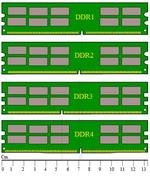
TTL to CMOS and CMOS to TTL Conversion
Learn about converting between TTL and CMOS logic levels, including voltage levels, converter circuits, and interfacing applications.
Advertisement

Learn about converting between TTL and CMOS logic levels, including voltage levels, converter circuits, and interfacing applications.

Explore TTL to CMOS and CMOS to TTL interfacing techniques, including interfacing LEDs and lamps. Learn about voltage level considerations and circuit configurations.
Compare TTL, CMOS, and ECL logic families based on parameters like fan-out, power consumption, noise immunity, and propagation delay in IC designs.

Explore the key differences between TTL and LVTTL, including voltage levels, advantages, and disadvantages, for digital logic applications.

Explore the distinctions between tubular and flat plate batteries, including their construction, performance, applications, and advantages.

A comparison of UFS (Universal Flash Storage) versions 2.0, 2.1, 3.0, and 3.1, highlighting the differences in speed and IOP/sec.
Explore the differences between UL Class 1 and Class 2 LED drivers, including safety, voltage limits, and application considerations.

An overview of AEC Q100, Q101, Q102, Q104, and AEC Q200 standards for stress test qualification of components used in automotive applications.

Explore DDR SDRAM, its evolution from DDR1 to DDR4, and its advantages in speed, power efficiency, and system performance over SDR SDRAM.

Explore the working principles of IMU sensors, including accelerometers, gyroscopes, and magnetometers, and their applications in modern electronics for motion tracking and orientation detection.

Explore the lifespan of LEDs, ranging from 50,000 to 100,000 hours, and the factors that influence their longevity, including temperature, power supply, and environment.
Explore MIL-PRF-38534, the military specification for microcircuits. Learn about design, manufacturing, quality assurance, and testing requirements for military and aerospace applications.

Explore the construction, operation, advantages, and applications of Permanent Magnet Synchronous Motors (PMSMs), known for their high efficiency and precise control.

Explore PMDC (Permanent Magnet DC) motors: their components, working principle, and widespread applications in appliances, tools, and vehicles.
The holding current is the minimum current required to keep an SCR in the 'ON' state. Learn how it works and why it is crucial in circuit design.
Explore the firing angle of a thyristor (SCR), its importance in power control, and various methods for enabling SCR conduction.

Explore Transistor-Transistor Logic (TTL) circuits, including NAND gates, inverters, and level converters. Learn about their operation, advantages, and disadvantages.

Compare USB 2.0, USB 3.0, and MIPI CSI-2 interfaces for embedded systems, highlighting bandwidth, space, and development costs.

Explore the distinctions between VMOS and UMOS transistors, including their structures and functionalities.

Explore voltage level shifting techniques for converting between 3.3V and 5V, including resistor dividers, MOSFET circuits, and bi-directional logic level converters.
Advertisement